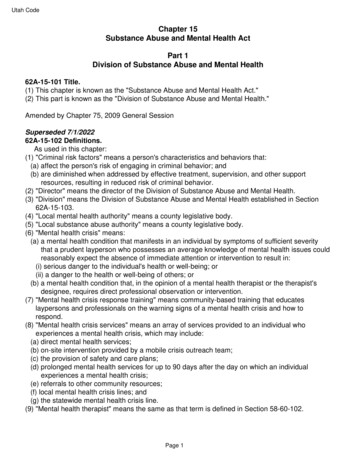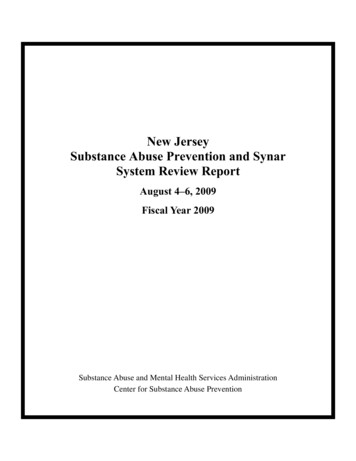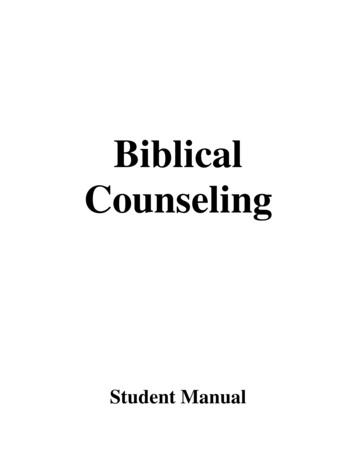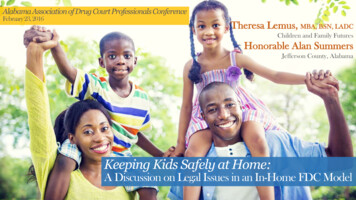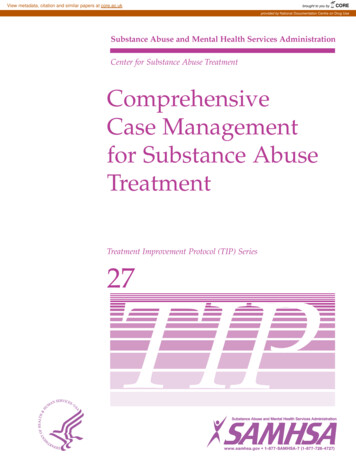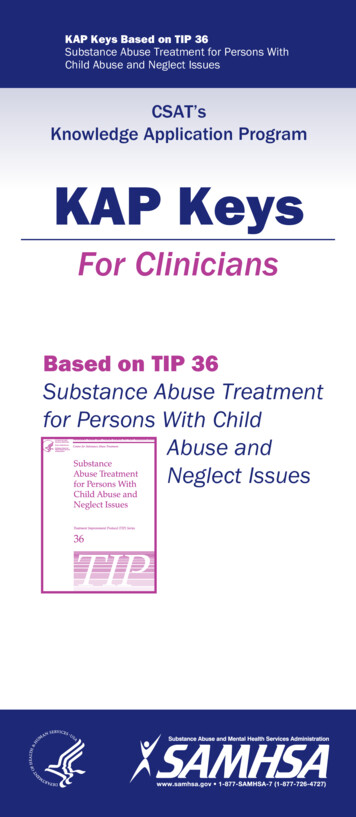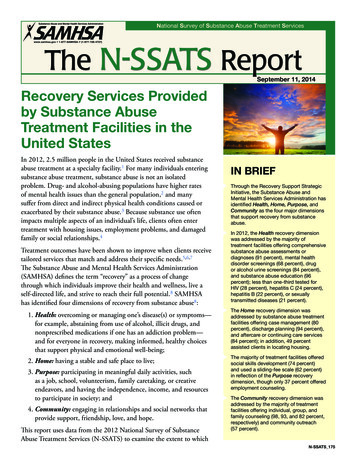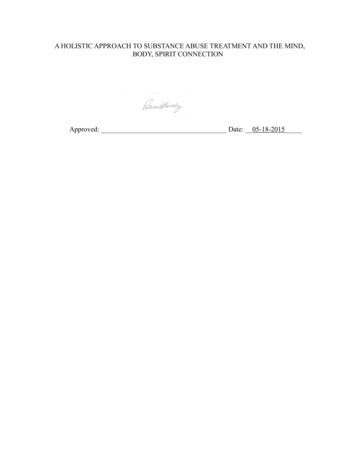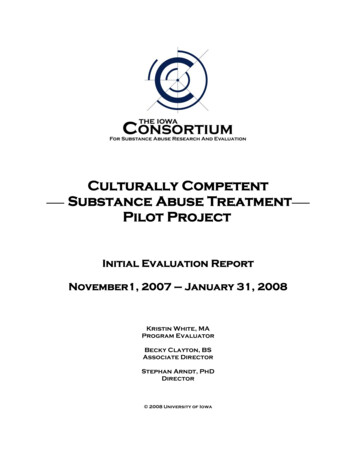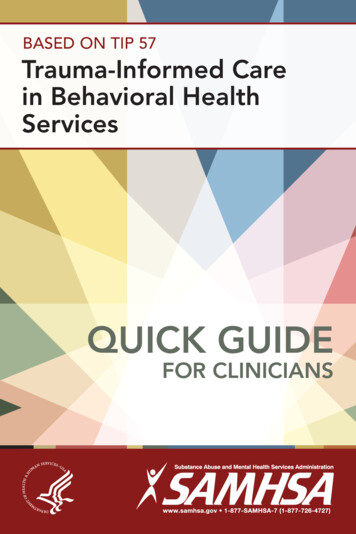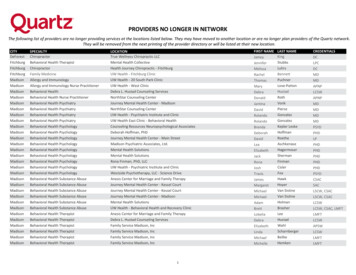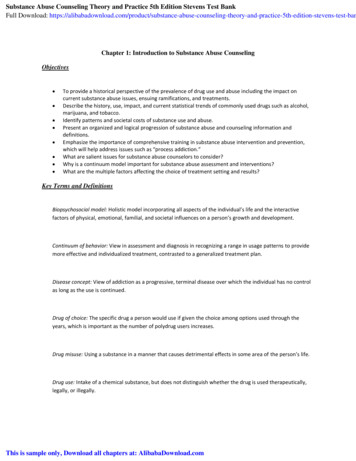
Transcription
Substance Abuse Counseling Theory and Practice 5th Edition Stevens Test BankFull Download: ns-test-banChapter 1: Introduction to Substance Abuse CounselingObjectives To provide a historical perspective of the prevalence of drug use and abuse including the impact oncurrent substance abuse issues, ensuing ramifications, and treatments.Describe the history, use, impact, and current statistical trends of commonly used drugs such as alcohol,marijuana, and tobacco.Identify patterns and societal costs of substance use and abuse.Present an organized and logical progression of substance abuse and counseling information anddefinitions.Emphasize the importance of comprehensive training in substance abuse intervention and prevention,which will help address issues such as “process addiction.”What are salient issues for substance abuse counselors to consider?Why is a continuum model important for substance abuse assessment and interventions?What are the multiple factors affecting the choice of treatment setting and results?Key Terms and DefinitionsBiopsychosocial model: Holistic model incorporating all aspects of the individual’s life and the interactivefactors of physical, emotional, familial, and societal influences on a person’s growth and development.Continuum of behavior: View in assessment and diagnosis in recognizing a range in usage patterns to providemore effective and individualized treatment, contrasted to a generalized treatment plan.Disease concept: View of addiction as a progressive, terminal disease over which the individual has no controlas long as the use is continued.Drug of choice: The specific drug a person would use if given the choice among options used through theyears, which is important as the number of polydrug users increases.Drug misuse: Using a substance in a manner that causes detrimental effects in some area of the person’s life.Drug use: Intake of a chemical substance, but does not distinguish whether the drug is used therapeutically,legally, or illegally.This is sample only, Download all chapters at: AlibabaDownload.com
Drug user or substance abuser: Person who intentionally takes legal or illegal drugs to alter his or herfunctioning or state of consciousness.Enkephalins and endorphins: Neurotransmitters in the brain which are naturally produced pain-killing chemicalwhich have a strong molecular resemblance to alcohol and opiates.Social learning systems model: View of substance abuse as a learned coping behavior that is regulated andmaintained by interacting systems, including the family and society.Substance or chemical: Terms refer to use of alcohol, nicotine, caffeine, prescription drugs, and illegal drugs.Substance abuse: Continued use of a psychoactive drug despite the occurrence of major detrimental effectsassociated with its use, such as, social, vocational, health, scholastic, or economic difficulties.Tolerance: A higher dosage of is needed to produce the same level of effect over time.Withdrawal: A specific set of symptoms that occur when use of the drug is discontinued or withdrawn fromthe central nervous system.Key WebsitesAmerican Psychological Association home page, http://www.apa.org/American Counseling Association home page, http://www.counseling.org/Community Anti-Drug Coalitions of America (CADCA), http://www.cadca.orgCSAP Resource Guide, http://store.health.org/catalog/results.aspx?topic 95HHS, National Institutes of Health (NIH), http://www.nih.gov/
HHS, NIH National Institute of Mental Health (NIHM), http://www.nimh.nih.gov/HHS, SAMHSA Center for Mental Health Services (CMHS), http://mentalhealth.samhsa.gov/cmhs/History of Drug Use in the United States, http://www.a1b2c3.com/drugs/gen003.htmIowa Substance Abuse Information Center (ISAIC On-line), http://www.drugfreeinfo.org/Minnesota Institute of Public Health, http://www.miph.org/links.htmlNational Association of Alcoholism and Drug Abuse Counselors (NAADAC), http://www.naadac.orgNational Association of Social Workers home page, http://www.socialworkers.org/National Clearinghouse for Alcohol and Drug Information (NCADI), http://www.health.orgNational Council on Alcoholism and Drug Dependence, http://www.ncadd.org/National Household Survey of Drug Use and Health, nal Institute on Alcohol Abuse and Alcoholism (NIAAA), http://www.niaaa.nih.gov/National Institute on Chemical Dependency, http://www.ni-cor.com/addictions.htmlNational Institute on Drug Abuse, http://www.nida.nih.gov/Partnership for Drug-Free America, http://www.drugfreeamerica.org
SAMHSA’s National Mental Health Information xplore/substanceabuse/SAMHSA’s Office of Applied Studies, http://www.drugabusestatistics.samhsa.gov/Sober Houses, http://www.sober.comStarfish Foundation, http://www.starfishfoundation.org/U.S. Department of Health and Human Services (HHS), http://www.hhs.gov/U.S. Department of Justice (DOJ) & Drug Enforcement Administration (DEA), http://www.dea.govWhite House Office of National Drug Control Policy (ONDCP), http://www.whitehousedrugpolicy.govWorld Health Organization, http://www.who.orgActivities1.Drugs are often in the news - drug abuse, drug dealing and more. As a class, over a period of several days,search the newspaper for stories that involve drugs. Separate the stories you find into categories under the headings, "Local", "National", and"International". Which type of story is most common in your newspaper? Why do you think that is the case?2.Look on the internet for recent statistics on local trends in substance use or abuse for your community. How do these patterns compare to the national statistics presented in this chapter?3.Interview someone about the effect that alcohol and/or drugs have had on his or her family. What are the “costs” (i.e. financial, physical, and psychological) that he or she perceives alcoholand/or drugs have had on his or her family?
4.Think of a client who might be moving along the continuum from use to abuse. How might you explain this progression to that individual?5.Compare 2 to 3 substance abuse journals (that are both refereed and non-refereed). Discuss the topics, trends, and population samples. What differentiates the journals from each other? Rate the helpfulness of the articles (Would you use these particular types of journals?). What differences, if any, are there between refereed vs. non-refereed journals?6.Group discussion: There has been a longstanding debate about the pros and cons of legalizing marijuana.Defend your stance on this topic.7.Group discussion: Identify historical/cultural influences on the ways in which substances have traditionallybeen used in your community or within your family, e.g. in celebrating religious or national holidays. Would modifying or removing substance use strongly affect community or family traditions?Essay Questions/ Discussion Starters1.Discuss the relationship between social structures, culture, and the use of substances throughout history.Answer 2.Explain the differences between substance use, misuse, abuse and dependence.Answer 3.Use DSM diagnosis to provide differences in categoriesEither from your own experiences, from observing others, or from readings, analyze the factors influencing theuse of different drugs—tobacco, alcohol, marijuana, cocaine, etc.Answer 4.Use as medicinal substanceUse in religious ritualsUse in celebratory situationsUse instead of waterInclude social, cultural, familial, genetic and legal aspects of use. Include psychological mindset ofindividual.Critique or defend the concept of “we live and always will live in a society of drug use and abuse.” Discussfactors related to this statement and costs involved.Answer Include aspects of historical overview of the use of drugs throughout history.Include psychological need as well as medicinal use.
Multiple Choice Questions1.2.3.4.5.Throughout history, drugs have been used for purposes.(a)Medicinal(b)Religious(c)Social(d)All of theseSubstance abuse .(a)Is so prevalent that it is viewed outside of the context of other problems presented by clients(b)Is considered no longer a “major” problem among adolescents(c)Is intertwined with the majority of other problems that clients present in therapy(d)Is affecting a smaller percent of the population today when excluding the misuse of tobaccoAccording to a 2009 SAMHSA survey, the following is true about U.S. tobacco use:(a)Almost 30% (27.7%) of Americans aged 12 or older were current users of a tobacco product(b)Almost 50% (46.6%) of Americans aged 12 or older were current users of a tobacco product(c)Almost 75% (74.4%) of Americans aged 12 or older were current users of a tobacco product(d)Almost 90% (88.8%) of Americans aged 12 or older were current users of a tobacco productAlcohol use is:(a)Highly correlated with suicide attempts(b)A major factor in acts of domestic violence(c)Frequently mentioned in traffic accidents as a mitigating factor(d)All of the aboveWhich of the following is not true for marijuana or cannabis?
6.7.8.(a)Historically, hemp was farmed for use as paper, clothing, and rope.(b)It was used for patients with depression.(c)It has not been recognized by the DEA as having medicinal use(d)It has not been legalized for common usage in most states of the U.S.The most commonly used drug among Americans aged 12 or older cription-type drugs used nonmedicallyCosts associated with ATOD use, abuse and dependency:(a)Is estimated to be anywhere from 180 billion to approximately 484 billion(b)Includes a cost estimate of 64 billion in 2000 for health care and productivity losses(c)Represented 8% of the total national health expenditures in 1996(d)Have been estimated to be on the decline due to treatment efficacy and educational programsWhen referring to a “substance” or “chemical”, the authors include:(a)All illegal drugs(b)Prescription drugs and illegal drugs(c)Alcohol, prescription drugs, and illegal drugs(d)Alcohol, nicotine, caffeine, prescription drugs, and illegal drugs
9.10.11.12.13.Historically speaking:(a)Opioids, amphetamines, and hallucinogens are the drugs that have been around and abused for thelongest period of time(b)Drug use including that of alcohol, marijuana, and tobacco has been around for centuries(c)Caffeine is an American phenomenon and recently examined as a potential drug(d)Alcohol and marijuana are relatively new drugs used by Western civilizationThe definition of a drug relates to:(a)Its legality(b)Prescription vs. street use(c)The degree of its “instrumentality”(d)Its ability to significantly alter structure, function, or perceptionThe diagnostic categories of “abuse” and “dependence” are separated by the following:(a)Tolerance and withdrawal(b)Length of time used and context of use(c)Length of time used and particular drug identified(d)Withdrawal and recidivismThe particular nature of withdrawal is contingent on .(a)The class or type of drug being taken(b)The length of time taken and the amount of the chemical taken(c)The health of the individual(d)All of the aboveMisuse, abuse, and addiction is a behavior.
14.(a)Consistent(b)Genetic(c)Continuum of(d)Fixation ofA continuum model implies .(a)That some users may progress but that other users may fixate at a particular position(b)Progression of drug use(c)A level of drug use(d)None of the above15. According to the U.S. Department of Transportation, an average of one alcohol-impaired driving fatalityoccurred every in 2009.16.17.(a)48 seconds(b)48 minutes(c)48 hours(d)48 daysFriedrich Serturner found the active ingreadient of opium by dissolving it in acid and then neurtralizing it withammonia. The result was .(a)Alkaloids(b)Principium Somniferum(c)Morphine(d)All of the aboveSoldiers disease was an addiction to .(a)Alcohol(b)Heroine
18.19.20.21.(c)Morphine(d)OxycodoneThe Harrison Narcotics Act .(a)Was aimed to curb drug abuse(b)Required doctors and pharmacists and others who prescribed narcotics to register and pay a tax(c)Created a significant change in the use and availability of opioids(d)All of the above.Marijuana has been legalized in states in the United States.(a)6(b)16(c)26(d)36The American Indian Religious Act in 19788 and its amendment in 1994 provided natives with the right to.(a)Use peyote (a cactus) in religious services(b)Use a piece pipe in religious services(c)Dance the traditional American Indian dances in religious services.(d)Hold religious services especially for American IndiansEvidence-based practices for treatment have been .(a)Subjected to randomized clinical trials and other experimental designs(b)Found to be more effective than “treatment as usual”(c)Both a and b(d)None of the above
Substance Abuse Counseling Theory and Practice 5th Edition Stevens Test BankFull Download: ns-test-ban22.23.24.The use of motivational interviewing is an example of .(a)Collaborative and Positive Treatment Skills(b)“Treatment as usual”(c)Confrontation as treatment(d)All of the aboveIn the 1930’s, what replaced the now-illegal cocaine?(a)Heroin(b)Marijuana(c)Synthetic Amphetamines(d)OpioidsAfter 1910, public health officials began to campaign .(a)Against chewing tobacco(b)For smoking tobacco(c)Against drinking alcohol(d)For drinking alcoholThis is sample only, Download all chapters at: AlibabaDownload.com
Drug misuse: Using a substance in a manner that causes detrimental effects in some area of the person's life. Drug use: Intake of a chemical substance, but does not distinguish whether the drug is used therapeutically, legally, or illegally. Substance Abuse Counseling Theory and Practice 5th Edition Stevens Test Bank
